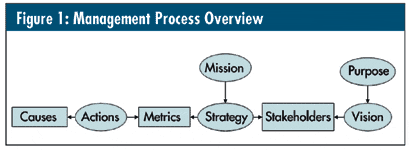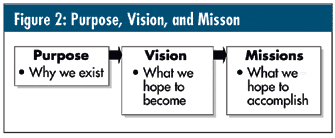Introducing Quality 2.0
Welcome to the inaugural Quality 2.0 column! Over the past several years it has become increasingly obvious (to me, anyway) that quality has grown beyond its commonly accepted domain. Now I will explore the "new" quality, which I call Quality 2.0, and which includes Six Sigma, lean, and traditional quality topics. I will use this first column to define the concept and to show its relationship to management in general.
I've always been confused by the terms "purpose," "vision," and "mission." Nonetheless, understanding organizations requires a common definition of these terms, and, since this is my column, I'll just take the bold step of making my own.
For example, the fictitious Acme Corp. might have the following purpose, vision, and mission:
• Purpose: Acme will discover new technologies and develop them commercially to improve the human condition. Our goal is progress!
• Vision: Acme will be No. 1 or No. 2 in all markets where it participates.
• Mission : Every home in the United States will have at least one Acme product.
Organizations consist of active stakeholders who help the organization pursue its mission. Active stakeholders commit time or resources to the organization. Passive stakeholders are people other than active stakeholders who are affected by the activities or outputs of the organization. Here, I refer to active stakeholders.
I define "management" as the process of harmonizing stakeholders' interests to achieve the organization's mission in pursuit of its vision and purpose. Figure 1 illustrates the management process. Ellipses represent abstractions or goals, while rectangles represent elements that can be measured.


The process of management is identifying, measuring, and meeting the requirements of stakeholders who help the organization pursue its vision and purpose. These stakeholders might be investors who help finance the organization, employees who do the actual work, or customers who use its products. Once the stakeholder requirements are known, the leadership develops missions and strategies to meet the requirements while minimizing adverse consequences for passive stakeholders. Strategies are put into operation via metrics. Actions (e.g., plans, projects, and routine activities) are taken to move the metrics by changing underlying causes.
Although the purpose of the organization seldom changes, vision and mission are sometimes changed by leaders. For example, consider the following two visions for Acme:
• Old vision: Acme will be a competitive organization.
• New vision: Acme will be No. 1 or No. 2 in all markets where it participates.
Such a change in vision will drive innumerable missions, strategies, and actions at all levels in the organization. Many current stakeholders will choose not to be a part of the new organization, while some nonstakeholders will want to become stakeholders. Management will be dramatically altered.
With Quality 2.0, quality is defined as meeting the promises made to stakeholders.
These promises can be explicit, such as product warranties, or implicit, such as ethical behavior and the safety of the community. This definition is much broader than the traditional, customer-based definitions such as conformance to requirements or fitness for use. Of course, the new definition subsumes the traditional definitions of quality rather than invalidating them. This new definition redefines the role of the quality function.
• Purpose: The quality function exists to help the organization improve quality.
• Vision: An organization that keeps all its promises
• Mission: Provide expertise, oversight, and guidance to leaders and employees pursuing quality improvement.
In future columns, I will expand and modify these ideas. I welcome reader input to critique and further develop them.
Thomas Pyzdek, author of The Six Sigma Handbook (McGraw-Hill, 2003), The Quality Engineer Handbook (Marcel Dekker, 2003), and The Handbook of Quality Management (Quality Publishing, 2000), provides consulting and training to clients worldwide. Visit him at www.pyzdek.com .
|